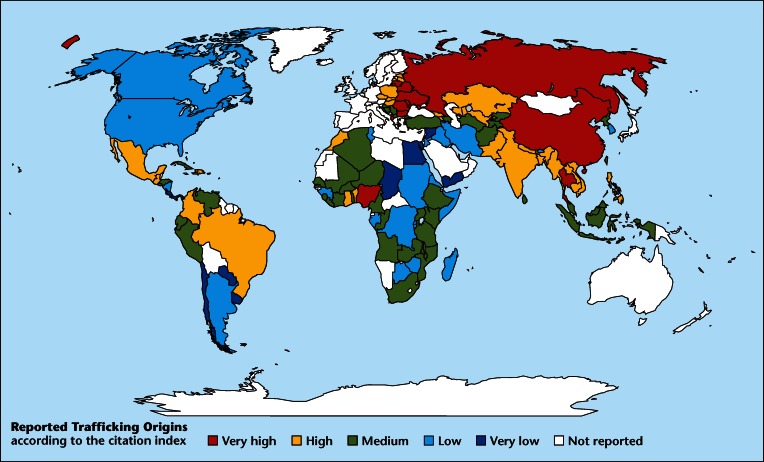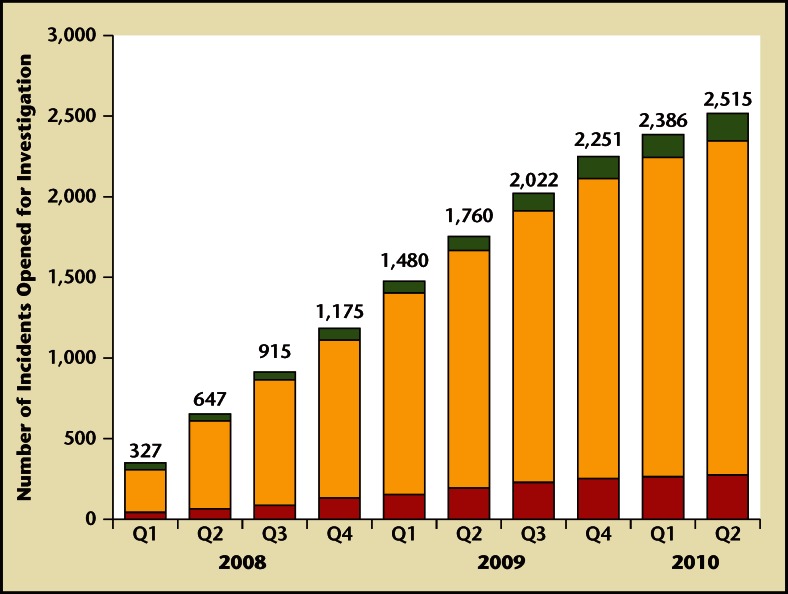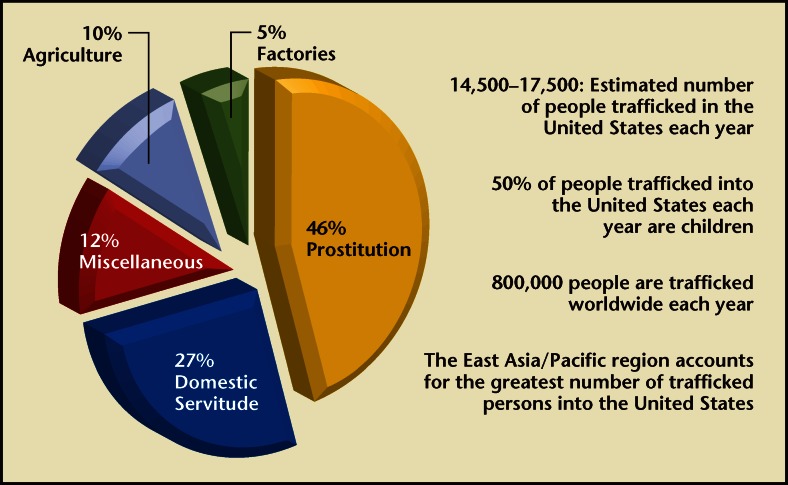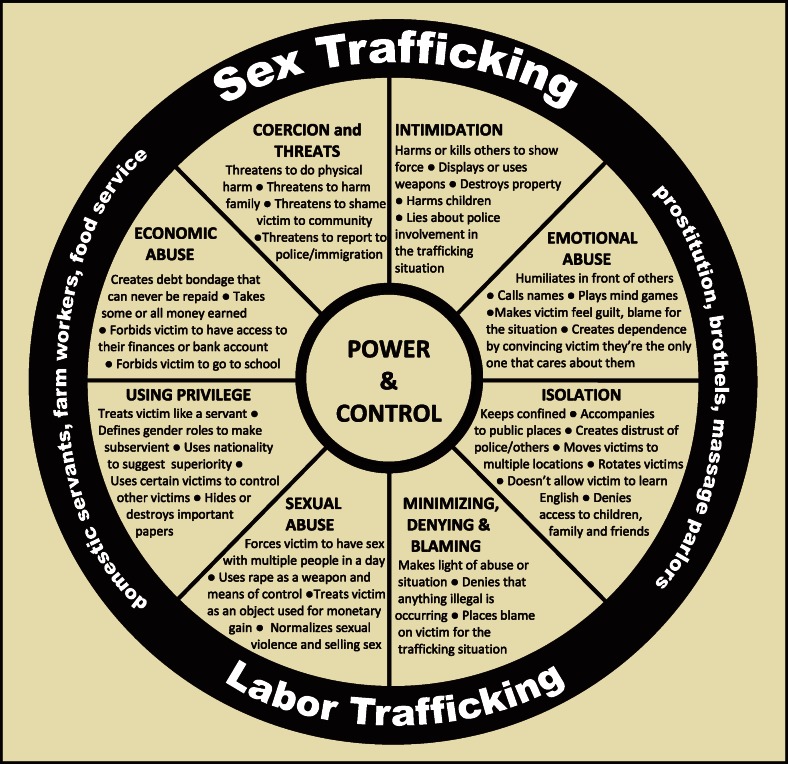Sex Trafficking of Women and Girls (original) (raw)
Abstract
Sex trafficking involves some form of forced or coerced sexual exploitation that is not limited to prostitution, and has become a significant and growing problem in both the United States and the larger global community. The costs to society include the degradation of human and women’s rights, poor public health, disrupted communities, and diminished social development. Victims of sex trafficking acquire adverse physical and psychological health conditions and social disadvantages. Thus, sex trafficking is a critical health issue with broader social implications that requires both medical and legal attention. Healthcare professionals can work to improve the screening, identification, and assistance of victims of sex trafficking in a clinical setting and help these women and girls access legal and social services.
Key Words: Sex trafficking, Human rights, Women’s rights
Human trafficking is a modern-day form of slavery that involves the illegal trade of human beings for the purpose of some form of forced exploitation. The United Nations Office On Drugs and Crime (UNODC) defines human trafficking as any form of recruiting, transporting, transferring, harboring, or receiving a person by means of threat or use of force or other forms of coercion, abduction, fraud, or deception.1 There are approximately 800,000 people trafficked across international borders annually and, of these, 80% are women or girls and 50% are minors.2 Although the degree of trafficking among countries and continents is variable, it is clear that global trafficking has become a growing problem (Figure 1).
Figure 1.
Human trafficking origins. Reproduced with permission from United Nations Office on Drugs and Crime (UNODC). Trafficking in Persons: Global Patterns. Vienna: UNODC; April 2006:38.
The two most common purposes for human trafficking are sexual exploitation and forced labor (Figures 2, 3). Victims of sex trafficking are forced into one or more forms of sexual exploitation. It is important to note that sex trafficking and prostitution are not synonymous and that prostitution is simply one type of work performed by victims of sex trafficking. Sex trafficking is an umbrella term that may include commercial sex work such as prostitution, but also pornography, exotic dancing, stripping, live sex shows, mail-order brides, military prostitution, and sexual tourism. Although victims of sex trafficking can be of any age and of either sex, the majority are women and adolescent girls. Although many nations have outlawed the trafficking of females, it is still widely prevalent on a global scale.
Figure 2.
Cumulative number of incidents of human trafficking between January 2008 and June 2010. Reproduced with permission from US Department of Justice, Bureau of Justice Statistics. Characteristics of Suspected Human Trafficking Incidents, 2008–2010. Washington, DC: US Department of Justice; 2011.
Figure 3.
Prevalence of global human trafficking. Source: US Department of Health and Human Services, US Department of Justice, and Free the Slaves.
Methods of Coercion, Recruitment, and Enslavement
There are several recurrent tactics of manipulation used to coerce victims into situations of sex trafficking (Figure 4). Most commonly, victims are promised a good job, education, or citizenship in a foreign country or offered a false marriage proposal that is turned into bondage. Many victims are sold into the sex trade by parents, husbands, and significant others, whereas others are unwillingly and forcibly kidnapped by traffickers. The most common tactic of coercion used among victims is debt bondage, an illegal practice where the victim has to pledge personal services in order to repay some form of debt, such as transportation into a foreign country or living expenses.3 Sex traffickers may often approach families living in poverty and seek to purchase girls or young women with the promise of a better life in a richer nation or may approach women who are already engaged in prostitution to be transported overseas. Another tactic used is traumatic bonding, where the victim is instilled with deeprooted fear coupled with gratitude for being allowed to live.
Figure 4.
The “power and control” wheel involved in sexual violence and exploitation. Reproduced with permission from Prolaris Project.
Traffickers and/or pimps commonly recruit potential victims who are either economically or socially vulnerable.3 These include women and girls who are susceptible to poverty, societal isolation, drug addiction, violence in the family, a history of child sexual abuse, family dysfunction, school failure, or a history of criminal behavior.4 It may also include orphans, women with physical disabilities, and those who are innumerate and illiterate.2 Typically, victims are recruited through either finesse or guerrilla pimping. Finesse pimping involves using compassion, kindness, and psychological games such as luring victims through small gifts of cash, clothes, shelter, food, and drugs that make them feel obligated or indebted to the pimp. Guerrilla pimping involves using violence, threats, intimidation, or aggression in order to recruit and then enslave the victim.
Once women and girls become involved in the sex trafficking industry, it becomes very difficult for them to escape. Victims may face legal barriers, where the traffickers will confiscate or sequester all forms of immigration and citizenry documentation. Language barriers, fear, limited knowledge, and lack of money are other barriers that women and girls may face to prevent them from escaping the sex trafficking ring. In many parts of the world, legacy prostitution, or the involuntary enslavement of future generations of girls in the sex trafficking industry, becomes an expected societal norm.
Magnitude of the Problem
The global sex trade is the fastest growing form of commerce, worth $32 billion annually. In fact, human trafficking is the fastest growing area of organized crime and the third largest income revenue for organized crime after narcotics and arms sales. What makes this business unique is that women and girls sold into sex trafficking earn profits for their pimps and traffickers over a great number of years, unlike the profits earned from drugs and narcotics that are sold and used only once.
Trafficking in the United States
The US Department of State estimates that anywhere from 14,500 to 17,500 people are trafficked in the United States annually. Victims tend to be recruited mostly from Mexico and East Asia, followed by the former Soviet Union, Africa, Eastern Europe, and, finally, Latin America.3 Typically, the countries from which many of the victims originate have unstable political climates and are economically disadvantaged. This facilitates trafficking, as it is easier to recruit and transport women, bribe officials, and forge passports and other travel documents.2 The United States is one of the top destinations for sex trafficking, and many children from the United States are trafficked to other industrialized nations, including the Netherlands, Germany, and Japan.2
Health Implications
Victims of sex trafficking are likely exposed to adverse conditions that can negatively affect their physical, mental, and emotional health. Physicians, nurses, midwives, and other healthcare providers can play critical roles in helping to identify victims of sex trafficking as a first step in providing both assistance and advocacy for affected women and girls. As a provider, one can play an essential role in providing interventions to improve physical and psychological health among victims and advocating on behalf of victims to help improve their social circumstances.
Physical
Sex trafficking victims are particularly susceptible to sexually transmitted infections such as gonorrhea, syphilis, urinary tract infections, and pubic lice. Human immunodeficiency virus/ AIDS infection is known to be prevalent.5 They may experience pelvic pain, vaginal/anal tearing, rectal trauma, and/or urinary difficulties as a result of commercial sex work. Sex trafficking victims are often physically abused and tortured. Providers should screen women and girls for physical injuries such as broken bones, bruises, burns, scars, and broken teeth/ dental problems. A history of concussions and head trauma should also be taken to screen for traumatic brain injury, which may result in memory loss, dizziness, headaches, and numbness. Food deprivation represents an indirect form of physical harm that also should be considered by screening victims for malnutrition.
Providers should also screen for unwanted pregnancy resulting from rape and prostitution, sterility, miscarriage, menstrual problems, mutilations, and forced or coerced abortions. Infectious diseases such as tuberculosis, hepatitis, malaria, and pneumonia may be more prevalent among sex trafficking victims as a result of unsanitary and dangerous housing conditions, use of needles, and inadequate access to health care.
Psychological
Victims of sex trafficking may face moderate to severe psychological trauma from daily mental, emotional, and psychological abuse and torture. Post-traumatic stress disorder, acute anxiety, and depression are all common psychological issues among sex industry workers. Providers should screen for feelings of helplessness, shame, humiliation, distrust, self-hatred, disbelief, denial, suicidal thoughts, disorientation, confusion, and phobias among suspected victims.4 It is not uncommon to encounter sex trafficking victims in their early 30s who have become psychologically and emotionally disabled from working in prostitution.6 In one study, providers reported that sex-trafficked women were less stable, more isolated, had higher levels of fear, more severe trauma, and greater mental health needs than other victims of crime.2 Furthermore, victims may develop substance abuse problems or addictions from being coerced through drug use by their traffickers or by using substances to cope or escape their desperate situations.
Social
Although there are insufficient data that report the social effects of sex trafficking, anecdotal evidence suggests that victims have a greater prevalence of illiteracy, homelessness, poverty, and societal isolation. Trafficked women engaging in sex work tend to have fewer resources, limited options, and increased vulnerability to violence and abuse than women who are not trafficked.7
Screening Questions to Identify Victims of Sex Trafficking
In 2004, the US Department of Health and Human Services implemented a campaign to increase the awareness of human trafficking in healthcare workers who may unknowingly interact with victims in their day-to-day work.8 Healthcare providers represent one of a few groups of professionals who may come in contact with victims of sex trafficking. In fact, one study found that 28% of trafficked women saw a healthcare professional while still in captivity.1
The following is a series of questions adapted from the US Department of Health and Human Services that guide healthcare providers to screen an individual in order to determine whether she is a victim of sex trafficking. Enlisting the help of staff who have a good understanding of the patient’s specific language and cultural needs can enhance the patientprovider relationship when seeking answers to these questions.
- 1. Where do you sleep and eat?
- Do you sleep in a bed, on a cot, or on the floor?
- Have you ever been deprived of food, water, sleep, or medical care?
- Are you required to ask permission for physical necessities?
- 2. What are your working and living conditions like?
- Are you able to come and go as you please?
- Can you leave your job or working situation if you want to?
- Are there locks on your doors and windows so you cannot leave?
- Are you allowed to talk to people outside your home or job?
- 3. Has anyone ever physically harmed you in any way?
- Have you ever been threatened if you try to leave your home or work?
- Has anyone ever threatened your family?
- 4. Has your identification or documentation been taken away from you?
- Is anyone forcing you to do anything that you do not want to do?
- Have you been or are you forced to have sex or perform sex acts?
Conclusions
Sex trafficking involves some form of forced or coerced sexual exploitation that is not limited to prostitution, and has become a significant and growing problem in both the United States and the larger global community. The costs to society include the degradation of human and women’s rights, poor public health, disrupted communities, and diminished social development. Victims of sex trafficking acquire adverse physical and psychological health conditions and social disadvantages. Thus, sex trafficking is a critical health issue with broader social implications that requires both medical and legal attention. Healthcare professionals can work to improve the screening, identification, and assistance of victims of sex trafficking in a clinical setting and help these women and girls access legal and social services.
Main Points.
- There are approximately 800,000 people trafficked across international borders annually and, of these, 80% are women or girls and 50% are minors.
- The global sex trade is the fastest growing form of commerce, worth $32 billion annually.
- Victims of sex trafficking acquire adverse physical and psychological health conditions and social disadvantages.
- Victims may face legal barriers, where the traffickers will confiscate or sequester all forms of immigration and citizenry documentation. Language barriers, fear, limited knowledge, and lack of money are other barriers that women and girls may face to prevent them from escaping the sex trafficking ring.
- Health care professionals can work to improve the screening, identification, and assistance of victims of sex trafficking in a clinical setting and help these women and girls access legal and social services.
References
- 1.United Nations Office on Drugs and Crime, authors. Human trafficking and migrant smuggling. [Accessed March 6, 2013].
- 2.Dovydaitis T. Human trafficking: the role of the health care provider. J Midwifery Womens Health. 2010;55:462–467. doi: 10.1016/j.jmwh.2009.12.017. [DOI] [PMC free article] [PubMed] [Google Scholar]
- 3.Hodge DR. Sexual trafficking in the United States: a domestic problem with transnational dimensions. Soc Work. 2008;53:143–152. doi: 10.1093/sw/53.2.143. [DOI] [PubMed] [Google Scholar]
- 4.McClain NM, Garrity SE. Sex trafficking and the exploitation of adolescents. J Obstet Gynecol Neonatal Nurs. 2011;40:243–252. doi: 10.1111/j.1552-6909.2011.01221.x. [DOI] [PubMed] [Google Scholar]
- 5.US Department of Health and Human Services, authors. Resources: Common Health Issues Seen in Victims of Human Trafficking. [Accessed March 6, 2013].
- 6.Estes RJ, Weiner NA. The Commercial Sexual Exploitation of Children in the U.S., Canada, and Mexico. Philadelphia: University of Pennsylvania; 2001. [Accessed March 6, 2013]. [Google Scholar]
- 7.Miller E, Decker MR, Silverman JG, Raj A. Migration, sexual exploitation, and women’s health: a case report from a community health center. Violence Against Women. 2007;13:486–497. doi: 10.1177/1077801207301614. [DOI] [PubMed] [Google Scholar]
- 8.US Department of Health and Human Services, Administration for Children and Families, Office of Refugee Resettlement, authors. Anti-trafficking in persons. [Accessed March 6, 2013].



